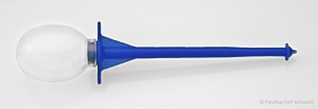Patients in this practice wear an indwelling-type voice prosthesis. This type of prosthesis is placed either in the operating room or in the office by the SLP staff and designed to be self-retaining (meaning, it is meant to stay in position until it is purposely removed). These are the latest in the evolution of low-maintenance voice prostheses.
It is very important, however, that these prostheses be properly cleaned to ensure proper function as well as the longest lifetime of the valve.
At the time of the initial prosthesis placement, you will be provided with a brush and a flush. We advise you clean your prosthesis twice a day, morning and evening, although intermittent cleaning during the day is also appropriate to assist with the function of the voice prosthesis as needed. The proper use of these is described during your appointment time as detailed below.
It is very important, however, that these prostheses be properly cleaned to ensure proper function as well as the longest lifetime of the valve.
At the time of the initial prosthesis placement, you will be provided with a brush and a flush. We advise you clean your prosthesis twice a day, morning and evening, although intermittent cleaning during the day is also appropriate to assist with the function of the voice prosthesis as needed. The proper use of these is described during your appointment time as detailed below.
Use of the Provox Brush

The brush should be first rinsed in water, then fully inserted through the lumen, or center, of the voice prosthesis, rotated in place, then withdrawn. The brush can be rinsed in water and the process repeated.
DO NOT “piston” the brush back and forth during cleaning. This may cause damage to the valve.
To clean the brush itself, it can be washed with soap and water and allowed to air dry. According to the manufacturer, you can also disinfect the Provox Brush with either hydrogenperoxide 3% for 60 minutes, ethanol 70% for 10 minutes or isopropylalcohol 70 % for 10 minutes at least once a day. Allow the brush to air dry after cleaning.
In many cases, the position of the voice prosthesis may make brush insertion difficult. The Provox brush is designed to be bent or angled, if needed, to assist with insertion. The SLP staff can assist you with this if necessary. The manufacturer recommends replacing the brush at least every 30 days.
The flush is designed to augment the brush when cleaning your voice prosthesis. Many patients ask why they need to use the flush when they regularly use the brush. In this case, its helpful to consider: When you brush your teeth, do you rinse after? Of course! The brush serves to loosen debris and biofilm from the prosthesis. Once loosened, however, it’s important to flush it away. Using both the brush and the flush will assist in prolonging the life of the voice prosthesis and ensuring it is functioning properly.
In many cases, the position of the voice prosthesis may make brush insertion difficult. The Provox brush is designed to be bent or angled, if needed, to assist with insertion. The SLP staff can assist you with this if necessary. The manufacturer recommends replacing the brush at least every 30 days.
The flush is designed to augment the brush when cleaning your voice prosthesis. Many patients ask why they need to use the flush when they regularly use the brush. In this case, its helpful to consider: When you brush your teeth, do you rinse after? Of course! The brush serves to loosen debris and biofilm from the prosthesis. Once loosened, however, it’s important to flush it away. Using both the brush and the flush will assist in prolonging the life of the voice prosthesis and ensuring it is functioning properly.
Use of the Provox Flush

The flush device should be used following use of the brush. Unlike the brush, the flush may take some practice to use properly. If you are having difficulty using the flush without leaking water into the trachea, the SLP staff can help you modify your technique.
DO NOT stop using the flush without notifying the SLP staff if you are experiencing difficulty.
As with the brush, the tip of the Provox flush can be angled somewhat to assist with proper placement against the prosthesis. The placement is very important to successful use and the SLP staff can help you with this if needed.
To use the flush, insert the tip fully into a cup of water, filling the bulb. Position the collar of the flush firmly against the prosthesis, inserting the tip into the center of the prosthesis. While maintaining firm pressure against the prosthesis, press the bulb to flush the water through. You should feel the water in your esophagus. Water leakage into the trachea is a sign the seal between the flush and the prosthesis is not sufficient. More pressure or an alternate angle may be required.
Release the pressure on the bulb and allow it to re-inflate before removing it from the voice prosthesis.
Although using the flush may require a little practice, it is an important part of your prosthesis care. The flush should be used after brushing, or at any other time during the day as needed to assist with optimal function of the voice prosthesis.
To clean the flush, the components should then be separated, cleaned with soap and water, then allowed to air dry.
According to the manufacturer, you can also disinfect the Provox Flush with either hydrogenperoxide 3% for 60 minutes, ethanol 70% for 10 minutes or isopropylalcohol 70 % for 10 minutes at least once a day.
The manufacturer recommends replacing the flush every 12 months.

